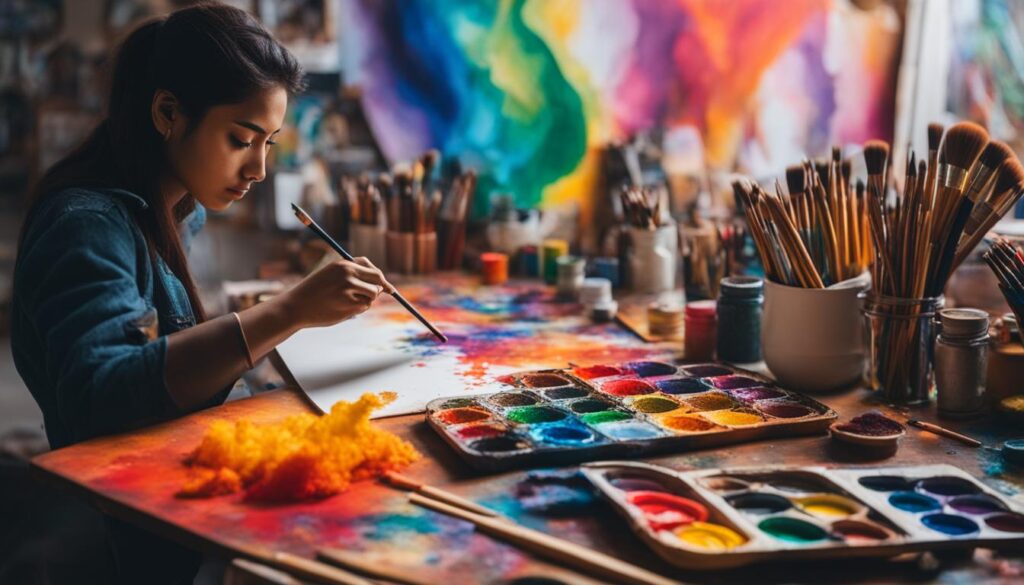We may earn money or products from the companies mentioned in this post.
When it comes to enhancing our mental health, we often focus on traditional methods such as therapy or medication. However, there is a growing recognition of the therapeutic benefits of creative outlets and art therapy. Engaging in artistic activities can be a powerful tool for self-expression, healing, and personal growth.
Creative outlets refer to any activity that allows us to express ourselves in a unique and personal way. This can include painting, drawing, writing, dancing, or even gardening. Art therapy, on the other hand, is a form of therapy that uses art as a means of communication and self-discovery. It is often used as a complementary therapy alongside traditional forms of therapy to enhance mental and emotional wellbeing.
Research has shown that engaging in artistic activities can reduce stress, improve mood, and promote relaxation. In addition, it can help individuals to connect with their emotions and find new ways of coping with life’s challenges. By incorporating creative outlets and art therapy into our lives, we can nurture our mental health and find new ways of expressing ourselves.
Key Takeaways
- Creative outlets and art therapy can enhance mental and emotional wellbeing
- Engaging in artistic activities can reduce stress and promote relaxation
- Art therapy can help individuals connect with their emotions and find new ways of coping
- By incorporating creative outlets and art therapy into our lives, we can nurture our mental health
- Self-expression is an important part of mental and emotional wellbeing
Understanding Art Therapy and its Benefits
Art therapy is a form of therapy that utilizes expressive art as a means of promoting mental and emotional wellbeing. It differs from traditional art in that it is not focused on creating a finished product, but rather on the process of creation itself.
Art therapy can take many forms, including painting, drawing, sculpting, and even music or dance. It is often used as a complementary therapy alongside more traditional forms of therapy or medication.
The benefits of art therapy are numerous. It offers a safe and non-judgmental space for individuals to explore and express their emotions. It can help reduce stress and anxiety, improve mood, and foster a sense of self-awareness and self-esteem.
“Art enables us to find ourselves and lose ourselves at the same time.” – Thomas Merton
Through the creative process, individuals can also gain insights into their thoughts and feelings, and explore new ways of coping with life’s challenges. For some, it can even provide a means of healing from past traumas or emotional wounds.
One of the key benefits of art therapy is its accessibility. It does not require any particular skill level or artistic talent, and can be adapted to suit individuals of all ages and abilities.
Whether used as a standalone therapy or combined with other treatments, art therapy offers a powerful means of promoting holistic wellbeing and supporting mental health.
Exploring Different Creative Outlets
There are many different types of creative outlets that can be used as a form of self-expression and therapeutic practice. Engaging in artistic activities can help individuals manage their emotions, reduce stress, and improve overall wellbeing. Below are a few examples of creative outlets that can be explored:
| Creative Outlet | Benefits |
|---|---|
| Painting | Allows for self-expression and exploration of emotions. Can be used as a tool for stress relief and relaxation. |
| Drawing | Provides a sense of accomplishment and can boost self-esteem. Can also be used to improve focus and concentration. |
| Sculpting | Allows for a tactile, hands-on experience that can be both calming and therapeutic. Can be used to explore themes of transformation and growth. |
| Writing | Provides a creative outlet for self-expression and can be used to process emotions and thoughts. Can also improve communication skills. |
| Music or Dance | Provides a physical and emotional release. Can be used to improve mood and reduce stress. |
It is important to find a creative outlet that resonates with you. Experiment with different art activities and explore what feels right. The process of exploring different creative outlets can be just as important as the final product. Don’t be afraid to try something new and have fun with it!
Through creative self-expression, individuals can learn more about themselves and their emotions, gaining insight and healing in the process. Incorporating a creative outlet into daily life can provide ongoing benefits for mental and emotional wellbeing.
Using Art as a Tool for Self-Discovery
Art has the power to heal and transform us, allowing us to explore our emotions and uncover our innermost thoughts. Through the act of creating, we can gain insights into ourselves and find new ways of coping with life’s challenges.
Using art as a tool for self-discovery can take many forms. For some, it may involve simply doodling or scribbling in a journal. For others, it may mean exploring new artistic mediums or styles. Whatever the form, the act of creating art can help individuals connect with their inner selves and unlock new dimensions of their personality.
One of the most significant benefits of using art for self-discovery is the process of reflection that it provides. When we create something, we are forced to confront our own thoughts and emotions, seeing them in a new light. This can be a challenging process, but it can also be incredibly rewarding, helping us to discover new aspects of ourselves and to gain a deeper understanding of our own minds.
Art can also be a powerful tool for coping with difficult emotions. When we are experiencing stress or anxiety, engaging in artistic activities can help us to release these emotions and to find a sense of peace and calm. Artistic expression can also be a way of working through difficult experiences or traumas, allowing us to process our emotions in a safe and supportive environment.
The Transformative Power of Art Therapy
For those seeking a more structured approach to using art for self-discovery, art therapy can be an incredibly powerful tool. Art therapy involves working with a trained therapist who can help guide individuals through the process of creating art and using it as a tool for healing and personal growth.
Through the use of specific art techniques and exercises, art therapy can help individuals explore their emotions, work through traumatic experiences, and develop new coping skills. In a safe and supportive environment, individuals can engage in expressive art and experience the transformative power of this form of therapy.
Whether engaging in artistic activities on their own or seeking out the guidance of an art therapist, individuals can use art as a tool for self-discovery and healing. By tapping into their own creativity and exploring their inner selves, individuals can find new ways of coping with life’s challenges and unlocking their full potential.
Incorporating Art Therapy into Daily Life
Art therapy is a powerful tool for promoting mental and emotional wellbeing. By incorporating therapeutic art into our daily lives, we can reduce stress, foster self-discovery, and find new ways of coping with life’s challenges.
Create a Supportive Environment
One of the first steps to incorporating art therapy into your daily life is to create a supportive environment. This may involve designating a specific space in your home for artistic activities, gathering the necessary materials, and setting aside time each day for creative expression.
“Art can permeate the very deepest part of us, where no words exist.” – Eileen Miller
Explore Different Mediums
Another way to incorporate art therapy into your daily life is to explore different mediums. There are countless ways to express yourself artistically, from drawing and painting to sculpture and collage. Find what resonates with you and allows you to tap into your emotions in a meaningful way.
Find Time for Creative Outlets
It’s important to find time for creative outlets within your daily routine. This may involve setting aside a specific time each day for artistic expression, such as before or after work. Alternatively, you may find that incorporating art therapy into your morning or evening routine helps you start or end the day on a positive note.
Make it Sustainable
Finally, it’s important to make art therapy a sustainable part of your daily life. This may involve starting small and gradually increasing the amount of time you spend on artistic activities, or finding ways to incorporate creativity into your work or social life. By making art therapy a regular part of your routine, you can reap the benefits of therapeutic art and improve your overall wellbeing.
Conclusion
Art therapy and creative outlets can benefit individuals seeking to improve their mental health and wellbeing. By exploring different creative outlets such as painting, writing, or music, individuals can find new ways to express their emotions and cope with the challenges of daily life.
Art therapy, in particular, has been shown to have significant benefits for individuals experiencing mental health issues. It provides a safe space for self-expression, allows individuals to explore their emotions in a non-judgmental environment, and can even promote physical healing.
By incorporating art therapy and creative outlets into our daily lives, we can promote long-term wellbeing and foster personal growth. Whether it’s taking a painting class or journaling before bed, finding ways to incorporate artistic activities into our routines can provide a sense of calm and fulfillment, helping us to cope with life’s challenges.
Overall, art therapy and creative outlets offer a powerful tool for promoting mental health and wellness. By embracing our creativity and allowing ourselves to express our emotions through art, we can find new ways to cope with stress, anxiety, and other mental health challenges. So, take some time to explore your creative side and find the artistic outlet that works best for you!
FAQ
What is art therapy?
Art therapy is a form of therapy that uses art as a means of self-expression and exploration. It allows individuals to communicate their thoughts, emotions, and experiences through creative activities.
How does art therapy benefit mental health?
Art therapy has been shown to have numerous benefits for mental health. It can help reduce stress, improve self-esteem, enhance self-awareness, and provide a sense of control and empowerment.
What are some examples of creative outlets?
Creative outlets can take many different forms. Some examples include painting, drawing, sculpting, writing, music, dance, and photography. The key is finding a medium that resonates with you and allows for self-expression.
How can art be used for self-discovery?
Art can be a powerful tool for self-discovery. Engaging in artistic activities can help individuals explore their emotions, uncover hidden thoughts and beliefs, and gain insight into their own experiences and identity.
How can I incorporate art therapy into my daily life?
Incorporating art therapy into your daily life can be as simple as setting aside a few minutes each day for creative activities. You can create a dedicated art space in your home, try different art mediums, and experiment with different techniques to find what works best for you.
Affiliate Disclosure: This post may contain affiliate links. If you purchase through our link, we may receive a small commission, but at no additional cost to you. For more information, please see our Disclosure statement.


